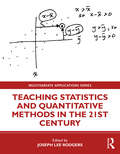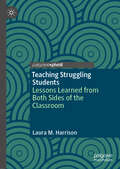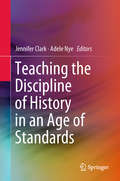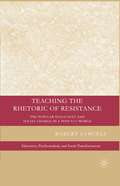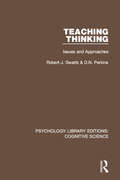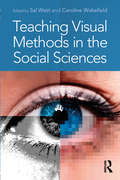- Table View
- List View
Teaching Statistics and Quantitative Methods in the 21st Century (Multivariate Applications Series)
by Joseph Lee RodgersThis work, which provides a guide for revising and expanding statistical and quantitative methods pedagogy, is useful for novice and seasoned instructors at both undergraduate and graduate levels, inspiring them to use transformative approaches to train students as future researchers. Is it time for a radical revision in our pedagogical orientation? How are we currently teaching introductory statistics and quantitative methods, and how should we teach them? What innovations are used, what is in development? This ground-breaking edited volume addresses these questions and more, providing cutting-edge guidance from highly accomplished teachers. Many current textbooks and syllabi differ in only superficial ways from those used 50 years ago, yet the field of quantitative methods—and its relationship to the research enterprise—has expanded in many important ways. A philosophical axiom underlying this book is that introductory teaching should prepare students to potentially enter more advanced quantitative methods training and ultimately to become accomplished researchers. The reader is introduced to classroom innovation, and to both pragmatic and philosophical challenges to the status quo, motivating a broad revolution in how introductory statistics and quantitative methods are taught. Designed to update and renovate statistical pedagogy, this material will stimulate students, new instructors, and experienced teachers.
Teaching Statistics and Quantitative Methods in the 21st Century (Multivariate Applications Series)
by Joseph Lee RodgersThis work, which provides a guide for revising and expanding statistical and quantitative methods pedagogy, is useful for novice and seasoned instructors at both undergraduate and graduate levels, inspiring them to use transformative approaches to train students as future researchers. Is it time for a radical revision in our pedagogical orientation? How are we currently teaching introductory statistics and quantitative methods, and how should we teach them? What innovations are used, what is in development? This ground-breaking edited volume addresses these questions and more, providing cutting-edge guidance from highly accomplished teachers. Many current textbooks and syllabi differ in only superficial ways from those used 50 years ago, yet the field of quantitative methods—and its relationship to the research enterprise—has expanded in many important ways. A philosophical axiom underlying this book is that introductory teaching should prepare students to potentially enter more advanced quantitative methods training and ultimately to become accomplished researchers. The reader is introduced to classroom innovation, and to both pragmatic and philosophical challenges to the status quo, motivating a broad revolution in how introductory statistics and quantitative methods are taught. Designed to update and renovate statistical pedagogy, this material will stimulate students, new instructors, and experienced teachers.
Teaching Struggling Students: Lessons Learned from Both Sides of the Classroom
by Laura M. HarrisonThis book tackles the phenomenon of limited learning on campuses by approaching it from the point of view of the author, an educator who writes about the experience of being, simultaneously, a college student and a college professor. The author lays out her experience as a student struggling in an introductory linguistics class, framing her struggles as sites ripe for autoethnographic interrogation. Throughout the book, the author melds her personal narratives with the extant research on college student learning, college readiness, and the interconnectedness of affect, intellect, and socio-cultural contexts. This book poses a challenge to the current binary metanarrative that circles the college student learning conundrum, which highlights either the faculty or student perspective, and unfolds this unnecessary binary into a rich, nuanced, and polyvocal set of perspectives.
Teaching Students Thinking Skills and Strategies: A Framework for Cognitive Education in Inclusive Settings
by Dorothy HowieThis book sets out the theory and outlines a model for implementing the teaching of thinking at whole-school, group and individual levels in inclusive settings. The model uses a three-tier approach to ensure that all learners are included: teaching thinking for all, working with small groups, and addressing individualised learning needs.
Teaching Systemic Thinking (The Systemic Thinking and Practice Series)
by David Campbell Ros Draper Clare HuffingtonTherapists recognise that the practice of systemic family therapy is as much about the way one thinks as it is about what one does, and this book was the first in this field to address specific ways of teaching people to think sytemically. It discusses the way people learn; the components of a successful teaching event; and many exercises which have proven helpful in changing the way people think. The book is based on seminars and courses given by the author over a twelve year period, and it is clearly and methodically written so the reader can easily apply the exercises to their own practice and teaching. Since systemic thinking is a growing field being applied to many different areas of work, this book has been enjoyed by a wide readership of people who work with families as well as large and small organisations.
Teaching Systemic Thinking (The Systemic Thinking and Practice Series)
by David Campbell Ros Draper Clare HuffingtonTherapists recognise that the practice of systemic family therapy is as much about the way one thinks as it is about what one does, and this book was the first in this field to address specific ways of teaching people to think sytemically. It discusses the way people learn; the components of a successful teaching event; and many exercises which have proven helpful in changing the way people think. The book is based on seminars and courses given by the author over a twelve year period, and it is clearly and methodically written so the reader can easily apply the exercises to their own practice and teaching. Since systemic thinking is a growing field being applied to many different areas of work, this book has been enjoyed by a wide readership of people who work with families as well as large and small organisations.
Teaching the Discipline of History in an Age of Standards
by Jennifer Clark Adele NyeThis book discusses the discipline standards of History in Australian universities in order to help historians understand the Threshold Learning Outcomes and to assist in their practical application. It is divided into two sections: The first offers a scholarly exploration of contemporary issues in history teaching, while the second section discusses each of the Threshold Learning Outcomes and provides real-world examples of quality pedagogical practice. Although the book focuses on the discipline of history in Australia, other subjects and other countries are facing the same dilemmas. As such, it includes chapters that address the international context and bring an international perspective to the engagement with discipline standards. The innovation and leadership of this scholarly community represents a new stage in the transformation and renewal of history teaching.
Teaching the Rhetoric of Resistance: The Popular Holocaust and Social Change in a Post-9/11 World (Education, Psychoanalysis, and Social Transformation)
by R. SamuelsAnalyzes diverse contemporary reactions to the depiction of the Holocaust and other cultural traumas in museums, movies, television shows, classroom discussions, and bestselling books. This work also describes several effective pedagogical strategies dedicated to overcoming student resistances to critical analysis and social engagement.
Teaching the World to Sleep: Psychological and Behavioural Assessment and Treatment Strategies for People with Sleeping Problems and Insomnia
by David R. LeeTeaching the World to Sleep provides a complete, science-based overview of sleep and sleep problems, from environmental, legal, and technological factors to assessment and treatment options. David R. Lee introduces the basic scientific concepts involved in sleep and provides a clear description of insomnias and the parasomnias. Teaching the World to Sleep discusses NICE-recommended Cognitive Behavioural Therapy for Insomnia (CBT-i) and the REST programme® and outlines considerations for at-risk groups, sleep and the law, and the application of dreams and dreaming in psychotherapy. This second edition includes a full update on research conducted since the publication of the first edition and includes new information on sleep in the legal setting, the rise of sleep apps and trackers and their impact on our sleep. Lee also considers neurodiversity, sleep in long Covid, rare and unusual sleep disorders and the delivery of treatment using the NHS-recommended stepped-care approach. Teaching the World to Sleep will be essential reading for psychotherapists, occupational therapists, and other professionals working with clients with sleep problems. It will also provide an accessible introduction to the science of sleep to readers looking to understand their own sleep problems.
Teaching the World to Sleep: Psychological and Behavioural Assessment and Treatment Strategies for People with Sleeping Problems and Insomnia
by David R. LeeTeaching the World to Sleep provides a complete, science-based overview of sleep and sleep problems, from environmental, legal, and technological factors to assessment and treatment options. David R. Lee introduces the basic scientific concepts involved in sleep and provides a clear description of insomnias and the parasomnias. Teaching the World to Sleep discusses NICE-recommended Cognitive Behavioural Therapy for Insomnia (CBT-i) and the REST programme® and outlines considerations for at-risk groups, sleep and the law, and the application of dreams and dreaming in psychotherapy. This second edition includes a full update on research conducted since the publication of the first edition and includes new information on sleep in the legal setting, the rise of sleep apps and trackers and their impact on our sleep. Lee also considers neurodiversity, sleep in long Covid, rare and unusual sleep disorders and the delivery of treatment using the NHS-recommended stepped-care approach. Teaching the World to Sleep will be essential reading for psychotherapists, occupational therapists, and other professionals working with clients with sleep problems. It will also provide an accessible introduction to the science of sleep to readers looking to understand their own sleep problems.
Teaching the World to Sleep: Psychological and Behavioural Assessment and Treatment Strategies for People with Sleeping Problems and Insomnia
by David R. LeeSleep problems are ubiquitous in the modern world, significantly impacting on quality of life, mental health, and performance at work and at home. More significantly, sleep problems accompany almost every mental health condition and are a significant driver in the development and maintenance of poor mental health. This book describes the current state of knowledge on the science of sleep, covering the various forms of insomnia and parasomnia that abound, before discussing the variety of assessment and treatment options available to the healthcare practitioner. Further discussion of psychological and behavioural interventions is made with particular reference to a new, second-generation Cognitive Behavioural Therapy for insomnia, how this is an effective treatment modality, and how it can be applied with clients presenting with more complex physical and mental health conditions. The final chapter presents the range of theories as to the purpose and function of dreams and dreaming, and how 'dream-work' has been applied in the therapeutic setting.
Teaching the World to Sleep: Psychological and Behavioural Assessment and Treatment Strategies for People with Sleeping Problems and Insomnia
by David R. LeeSleep problems are ubiquitous in the modern world, significantly impacting on quality of life, mental health, and performance at work and at home. More significantly, sleep problems accompany almost every mental health condition and are a significant driver in the development and maintenance of poor mental health. This book describes the current state of knowledge on the science of sleep, covering the various forms of insomnia and parasomnia that abound, before discussing the variety of assessment and treatment options available to the healthcare practitioner. Further discussion of psychological and behavioural interventions is made with particular reference to a new, second-generation Cognitive Behavioural Therapy for insomnia, how this is an effective treatment modality, and how it can be applied with clients presenting with more complex physical and mental health conditions. The final chapter presents the range of theories as to the purpose and function of dreams and dreaming, and how 'dream-work' has been applied in the therapeutic setting.
Teaching Thinking: Issues and Approaches (Psychology Library Editions: Cognitive Science)
by Robert J. Swartz D.N. PerkinsOriginally published in 1990, this title attempts to provide for the educational practitioner an overview of a field that responded in the 1980s to a major educational agenda. This innovative ‘agenda’ called for teaching students in ways that dramatically improved the quality of their thinking. Its context is a variety of changes in education that brought the explicit teaching of thinking to the consciousness of more and more teachers and administrators.
Teaching Thinking: Issues and Approaches (Psychology Library Editions: Cognitive Science)
by Robert J. Swartz D.N. PerkinsOriginally published in 1990, this title attempts to provide for the educational practitioner an overview of a field that responded in the 1980s to a major educational agenda. This innovative ‘agenda’ called for teaching students in ways that dramatically improved the quality of their thinking. Its context is a variety of changes in education that brought the explicit teaching of thinking to the consciousness of more and more teachers and administrators.
Teaching Tough Kids: Simple and Proven Strategies for Student Success
by Mark Le MessurierHow can you really make a difference for your students? Teaching Tough Kids delivers a refreshing collection of realistic ideas to sustain the organisational and behavioural transformations of all students, particularly those who 'do it tough'; who learn and react differently. They are complex kids who find life tougher than most. Managing their emotion and behaviour presents educators with a spectacular challenge in schools today, and numbers are on the rise. Filled with inspirational case studies, this book focuses on building improved relationships, structures and behaviours, rather than seeing the student as 'the problem' that must be fixed. Highlighting the value of promoting positive connections with students of all ages, the author presents ways to incorporate inclusive ideas into everyday practice and construct pathways for students to become engaged in their learning and achieve success. This stimulating book shows teachers how to: build student connectedness to learning; set achievable goals for each individual child; support emotional stability; strengthen organisation patterns; address behavioural issues; improve homework planning; create friendships and deal with bullying. Teaching Tough Kids takes a particularly close focus on students identified with Learning Disability, Attention Deficit Disorder, Attention Deficit Hyperactivity Disorder, Oppositional Defiant Disorder and Asperger Syndrome. Another group of students with executive functioning difficulties are emerging in schools. These are the kids who have endured neglect or too much stress and uncertainty in their lives and as a result display classic symptoms of hyperactivity, hyper vigilance and impulsivity. Teaching Tough Kids will be of immense interest to teachers, student teachers, staff in Pupil Referral Units, SENCos and all those involved with Behaviour Support work.
Teaching Tough Kids: Simple and Proven Strategies for Student Success
by Mark Le MessurierHow can you really make a difference for your students? Teaching Tough Kids delivers a refreshing collection of realistic ideas to sustain the organisational and behavioural transformations of all students, particularly those who 'do it tough'; who learn and react differently. They are complex kids who find life tougher than most. Managing their emotion and behaviour presents educators with a spectacular challenge in schools today, and numbers are on the rise. Filled with inspirational case studies, this book focuses on building improved relationships, structures and behaviours, rather than seeing the student as 'the problem' that must be fixed. Highlighting the value of promoting positive connections with students of all ages, the author presents ways to incorporate inclusive ideas into everyday practice and construct pathways for students to become engaged in their learning and achieve success. This stimulating book shows teachers how to: build student connectedness to learning; set achievable goals for each individual child; support emotional stability; strengthen organisation patterns; address behavioural issues; improve homework planning; create friendships and deal with bullying. Teaching Tough Kids takes a particularly close focus on students identified with Learning Disability, Attention Deficit Disorder, Attention Deficit Hyperactivity Disorder, Oppositional Defiant Disorder and Asperger Syndrome. Another group of students with executive functioning difficulties are emerging in schools. These are the kids who have endured neglect or too much stress and uncertainty in their lives and as a result display classic symptoms of hyperactivity, hyper vigilance and impulsivity. Teaching Tough Kids will be of immense interest to teachers, student teachers, staff in Pupil Referral Units, SENCos and all those involved with Behaviour Support work.
Teaching Undergraduates (Educational Psychology Series)
by Roger L. DominowskiThis practical guide is designed to help college teachers plan their undergraduate courses and deliver high-quality instruction. The book's theme is that teaching is a creative, decision-making, idea-testing enterprise whose purpose is to facilitate student learning in all of its facets. Its goal is to help instructors understand the multiple kinds of learning taking place in their courses so that they can select, devise, evaluate, and modify teaching techniques to improve their effectiveness. Based on research on human learning, memory, thinking, and problem solving, as well as studies of teaching and less-formal reports of teaching practices, the book offers concrete advice about all aspects of college teaching. *Part I is devoted to course planning. It outlines the many decisions instructors face in defining a course as their own and discusses the larger issues that shape a course and constrain some specific choices. Selecting course content, choosing learning goals, deciding how to pace a course, and scheduling tests are some of these issues. A workable timetable for preparing a course is included. *Part II is a mini-course on human learning, memory, and thinking. It provides the conceptual foundation for making teaching decisions, for selecting instructional strategies, and especially for inventing new techniques that might particularly fit a specific course. *Part III deals with the "nitty-gritty" of college teaching, including how to choose a textbook; lecturing and conducting classroom discussions; types and purposes of writing assignments, and how to structure and evaluate them; dealing with plagiarism; strengths and weaknesses of different types of tests, the relation of tests to learning goals, and guidelines for constructing good tests; and grading systems. *Part IV addresses professional and ethical issues of importance and consequence to instructors. New college instructors, more experienced faculty who would like to reflect on their teaching practices and consider making some changes, and teaching assistants will all find this book relevant and useful.
Teaching Undergraduates (Educational Psychology Series)
by Roger L. DominowskiThis practical guide is designed to help college teachers plan their undergraduate courses and deliver high-quality instruction. The book's theme is that teaching is a creative, decision-making, idea-testing enterprise whose purpose is to facilitate student learning in all of its facets. Its goal is to help instructors understand the multiple kinds of learning taking place in their courses so that they can select, devise, evaluate, and modify teaching techniques to improve their effectiveness. Based on research on human learning, memory, thinking, and problem solving, as well as studies of teaching and less-formal reports of teaching practices, the book offers concrete advice about all aspects of college teaching. *Part I is devoted to course planning. It outlines the many decisions instructors face in defining a course as their own and discusses the larger issues that shape a course and constrain some specific choices. Selecting course content, choosing learning goals, deciding how to pace a course, and scheduling tests are some of these issues. A workable timetable for preparing a course is included. *Part II is a mini-course on human learning, memory, and thinking. It provides the conceptual foundation for making teaching decisions, for selecting instructional strategies, and especially for inventing new techniques that might particularly fit a specific course. *Part III deals with the "nitty-gritty" of college teaching, including how to choose a textbook; lecturing and conducting classroom discussions; types and purposes of writing assignments, and how to structure and evaluate them; dealing with plagiarism; strengths and weaknesses of different types of tests, the relation of tests to learning goals, and guidelines for constructing good tests; and grading systems. *Part IV addresses professional and ethical issues of importance and consequence to instructors. New college instructors, more experienced faculty who would like to reflect on their teaching practices and consider making some changes, and teaching assistants will all find this book relevant and useful.
Teaching Visual Methods in the Social Sciences
by Caroline Wakefield Sal WattTeaching Visual Methods in the Social Sciences presents a practical and theoretical framework for those wanting to introduce visual methods into their curricula. Drawing on the expertise of contributors from across the social sciences, the book provides a comprehensive introduction to visual methodology, learning and teaching theory, and the ethical considerations involved. Divided into three parts, the book begins with an overview of how visual methods have been used in academic research, and how this can be applied to teaching and pedagogy. It then goes on to introduce different methods, including photography, film and drawing, describing how they can be used in various locations. Finally, the book pulls everything together, advocating the wider use of teaching visual methods in further and higher education curricula across the social science subjects. The book features a plethora of examples, as well as practical resources for FE and HE teachers, making it an essential companion for anyone interested in utilising visual methods in their teaching.
Teaching Visual Methods in the Social Sciences
by Caroline Wakefield Sal WattTeaching Visual Methods in the Social Sciences presents a practical and theoretical framework for those wanting to introduce visual methods into their curricula. Drawing on the expertise of contributors from across the social sciences, the book provides a comprehensive introduction to visual methodology, learning and teaching theory, and the ethical considerations involved. Divided into three parts, the book begins with an overview of how visual methods have been used in academic research, and how this can be applied to teaching and pedagogy. It then goes on to introduce different methods, including photography, film and drawing, describing how they can be used in various locations. Finally, the book pulls everything together, advocating the wider use of teaching visual methods in further and higher education curricula across the social science subjects. The book features a plethora of examples, as well as practical resources for FE and HE teachers, making it an essential companion for anyone interested in utilising visual methods in their teaching.
Teaching with a Strength-Based Approach: How to Motivate Students and Build Relationships
by Steven BaronHelping students improve doesn't have to mean remediating their deficits. In this important book, Steven Baron shows the benefits of a strength-based approach that instead emphasizes students' assets and capabilities, making them feel more connected to teachers and peers and more engaged in learning. You’ll learn practical, research-backed ways to help students of all grade levels identify and celebrate their strengths, develop self-confidence and a growth mindset, build intrinsic motivation, overcome a fear of making mistakes, manage their feelings, focus on gratitude, and more. You’ll also discover ways to create a more strength-based Individual Education Plan (IEP), increase your own resilience as a teacher, and build a strength-based culture throughout your school and district. The appendix provides a variety of exercises you can use to help students focus on their strengths, foster kindness, and understand the impact of bullying. Students spend approximately 1300 hours during the year with teachers; this resource will help you make this time as affirming as possible so students are ready to learn and grow.
Teaching with a Strength-Based Approach: How to Motivate Students and Build Relationships
by Steven BaronHelping students improve doesn't have to mean remediating their deficits. In this important book, Steven Baron shows the benefits of a strength-based approach that instead emphasizes students' assets and capabilities, making them feel more connected to teachers and peers and more engaged in learning. You’ll learn practical, research-backed ways to help students of all grade levels identify and celebrate their strengths, develop self-confidence and a growth mindset, build intrinsic motivation, overcome a fear of making mistakes, manage their feelings, focus on gratitude, and more. You’ll also discover ways to create a more strength-based Individual Education Plan (IEP), increase your own resilience as a teacher, and build a strength-based culture throughout your school and district. The appendix provides a variety of exercises you can use to help students focus on their strengths, foster kindness, and understand the impact of bullying. Students spend approximately 1300 hours during the year with teachers; this resource will help you make this time as affirming as possible so students are ready to learn and grow.
Teaching with Books that Heal: Authentic Literature and Literacy Strategies to Help Children Cope with Everyday Problems
by Patricia L. Kolencik Carianne BernadowskiHelp children learn coping skills through literature! This book answers the often repeated question: Is there a children's book I can read in my classroom to give children insight into significant life events? Literature ideas and activities help students cope with real-life situations, such as bullying, that interfere with school. This book will assist educators in guiding and nurturing children's special issues and concerns with outstanding, ready-to-go reading and writing lessons. This professional resource for K-6 educators and parents uses literature with identifiable characters to help children who are facing challenges in their lives. Like bullying, peer acceptance, peer pressure, and being different, as well as family situations such as death, divorce, adoption, and sibling rivalry.
Teaching with Sociological Imagination in Higher and Further Education: Contexts, Pedagogies, Reflections
by Christopher R. Matthews Ursula Edgington Alex ChannonThis book uses research and personal stories from university lecturers to explore pedagogical strategies that illuminate how students’ minds can be ‘switched on’ in order to unlock their extraordinary potential. It presents diverse ways to create inspiring learning environments, in chapters written by internationally respected experts in the broad field of the social sciences. Each author illustrates how – through their unique teaching philosophies and practices – they seek to enhance students’ experiences and promote their critical thinking, learning and development. The respective chapters provide conceptual arguments, personal insights and practical examples from a broad range of classrooms, demonstrating various ways in which students’ sociological imagination can be brought to life. As such, the book is both practical and theoretical, and is primarily aimed at educators working in both higher and further education institutions who wish to develop their understanding of classroom pedagogy as well as gain practical ideas for teaching and learning in the social sciences.
Teaching Writing in Chinese Speaking Areas (Studies in Writing #16)
by Mark Shiu-Kee Shum De-Lu ZhangOne of the most civilized nations in history, China has a long-standing writing tradition and many Chinese texts have become world treasures. However, the way the Chinese teach writing in various countries in contemporary times is little known to the outside world, especially in Western countries. Undoubtedly, the Chinese have had an established traditional method of writing instruction. However, recent social and political developments have created the perception amongst both practitioners and researchers of a need for change. Whilst certain socio-political changes, both in Mainland China and in the territories, acted as agents for reform of the teaching of composition, the shape these reforms are taking has been due to many different influences, coming both from inside the countries themselves and from foreign sources. Mainland China, Hong Kong, Taiwan and Singapore have each developed their own approach to the teaching of composition.
